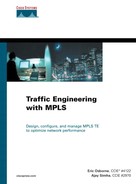Sample Network for Case Studies
In order to demonstrate the applicability of multiple concepts discussed in this chapter, a base network that resembles a medium-sized ISP network is necessary. It has a total of 168 routers in 14 POPs across the continental U.S. Refer to Figure 9-1 for most of the configurations and case studies in this chapter.
Figure 9-1. Sample Network for Case Studies

The network is divided into four regions:
Northeast
Central
Southeast
West
Each region is composed of four or five Points of Presence (POPs). Between POPs in a region, there's OC-48 connectivity; between regions, there's OC-12.
All POPs consist of two WAN routers that terminate the long-haul links between POPs, zero or more distribution routers, and three to 20 customer-facing routers. The WAN routers are called WRs, the distribution routers are DRs, and the customer routers are CRs. The naming scheme is POPNameRoleNumber. So the two WAN routers in Denver are DenverWR1 and DenverWR2.
If a POP has more than 11 CRs, it has three DRs; otherwise, it has zero DRs. This was done because some ISP networks use DRs and some don't, so we tried to cut somewhere down the middle. So a POP will look like either Figure 9-2 or Figure 9-3.
Figure 9-2. POP with 11 or Fewer CRs

Figure 9-3. POP with More Than 11 CRs

The entire network consists of 28 WRs, 12 DRs, and 128 CRs—a total of 168 routers. It's not the world's largest network, but it's certainly large enough to demonstrate the points made in this chapter.
CR uplinks (to either WR or DR, depending on POP topology) are OC-3 POS links. DR uplinks to WRs (where applicable) are OC-48s.
Because you'll need these numbers later for a case study, Table 9-1 provides the exact count of how many WRs, DRs, and CRs are in each POP.
| POP Location | WRs | DRs | CRs |
|---|---|---|---|
| Seattle | 2 | 3 | 14 |
| San Jose | 2 | 0 | 11 |
| San Diego | 2 | 0 | 8 |
| Denver | 2 | 0 | 3 |
| Dallas | 2 | 0 | 5 |
| Houston | 2 | 0 | 6 |
| St. Louis | 2 | 0 | 6 |
| Chicago | 2 | 0 | 7 |
| Atlanta | 2 | 0 | 9 |
| Raleigh | 2 | 3 | 12 |
| D.C. | 2 | 3 | 15 |
| New York | 2 | 3 | 20 |
| Boston | 2 | 0 | 8 |
| Miami | 2 | 0 | 4 |
All routers are at the same IS-IS level; they're all Level 2 neighbors. However, almost anything you do with IS-IS is possible with OSPF, so if you'd rather read about an OSPF network, just assume that the network is a single OSPF Area 0.
When discussing WR full mesh, it is only necessary for the WRs to be at the same level or area. The POPs can be in separate areas if that's how you'd rather picture them.
LDP on a TE TunnelIf your network offers MPLS VPN services or otherwise uses MPLS outside the TE cloud, you need to enable LDP (or TDP) on your MPLS TE tunnels. This is not discussed in this chapter; see Chapter 10, “MPLS TE Deployment Tips,” for details. |
For the sake of simplicity, assume the following about the network:
An OC-48 link has 2.4 Gbps of capacity and is configured with an IGP metric of 10.
An OC-12 link has 600 Mbps of capacity and an IGP metric of 41.
The link between WRs is an OC-48 with a cost of 2.
All loads specified on a link are not instantaneous load, but instead are measured over a longer interval—at least a few hours. The loads are 95th percentile.
NOTE
Although this topology was designed to look like a typical ISP, resemblance to any specific network, living or dead, is purely coincidental.
